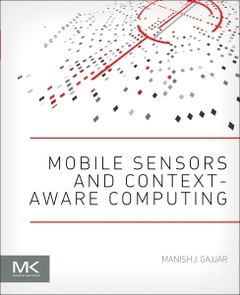Description
Mobile Sensors and Context-Aware Computing
Author: Gajjar Manish J.
Language: English
Subjects for Mobile Sensors and Context-Aware Computing:
Keywords
ACPI power states; Accelerometer calibration; Accelerometers; And sensor usages; Application processor-based sensor hub; Application-based power management; Augmented reality; Automotive industry; Autonomous power management; Biosensors; Calibration models; Cloaking; Color sensor calibration; Constraints; Context-aware computing; Context-aware framework; Dedicated microcontroller; Depth sensors; Encryption scheme; Energy harvesting; FPGA; FPGA-based sensor hub; Feature-based validation; Fiber optic health sensors; Forward watermark chain; Growth areas; Gyroscopes; Hardware-software codesign; Heart rate monitoring; Human-computer interaction; Introduction to mobile computing; K-anonymity; Light sensor; Location algorithms; Location awareness; Location privacy; Magnetic field sensors; Market trends; Obfuscation; Power management in sensors and sensor hub; Power management schemes; Power-saving firmware architecture; Pressure sensor; Proximity sensor; QEMU; Secret sharing scheme; Sensor calibration process; Sensor ecosystem; Sensor fusion; Sensor hub firmware; Sensor hub prototypes; Sensor hubs; Sensor needs; Sensor security; Sensor test cards; Sensor-based hub with MCU; Sliding group watermark scheme; Software sensor simulator; Temperature sensor; Ubiquitous computing; Validation matrix; Validation strategies; Virtual sensors; Windows sensor software stack
356 p. · 19x23.3 cm · Paperback
Description
/li>Contents
/li>Biography
/li>Comment
/li>
Mobile Sensors and Context-Aware Computing is a useful guide that explains how hardware, software, sensors, and operating systems converge to create a new generation of context-aware mobile applications. This cohesive guide to the mobile computing landscape demonstrates innovative mobile and sensor solutions for platforms that deliver enhanced, personalized user experiences, with examples including the fast-growing domains of mobile health and vehicular networking.
Users will learn how the convergence of mobile and sensors facilitates cyber-physical systems and the Internet of Things, and how applications which directly interact with the physical world are becoming more and more compatible. The authors cover both the platform components and key issues of security, privacy, power management, and wireless interaction with other systems.
1. Introduction2. Context-aware computing3. Sensors and actuators4. Sensor hubs5. Power management6. Software, firmware, and drivers7. Sensor validation and hardware–software codesign8. Sensor calibration and manufacturing9. Sensor security and location privacy10. Usability11. Sensor application areas
- Shows how sensor validation, calibration, and integration impact application design and power management
- Explains specific implementations for pervasive and context-aware computing, such as navigation and timing
- Demonstrates how mobile applications can satisfy usability concerns, such as know me, free me, link me, and express me
- Covers a broad range of application areas, including ad-hoc networking, gaming, and photography




